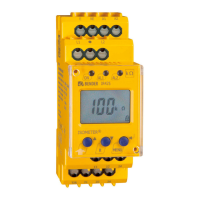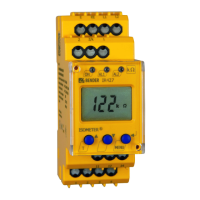Function
18
VME420_D00026_03_M_XXDE/04.2019
3.12 Factory setting FAC
After activating the factory setting, all settings previously changed are reset to
delivery status. In addition, the preset function allows automatic adaptation
of the response values in relation to the nominal voltage U
n
.
3.13 Erasable history memory
The first alarm value that occurs will be stored in this memory.
Subsequent alarms do not overwrite this "old" value. The memory can be
cleared using the Clr key in the menu HiS.
3.14 Alarm LEDs show which relay is in the alarm state
When the menu item LEd is activated, the alarm LED AL1 indicates that
K1 is in the alarm state. When AL2 lights up, K2 is in the alarm state. An alarm
relay cannot switch to the alarm state unless an alarm category has been
assigned to it.
When the menu item LEd is deactivated, AL1 signals overvoltage, AL2
signals undervoltage, both LEDs AL1 and AL2 light up in case of frequency
alarm.
For details about alarm category assignment to the respective relays refer to
the submenu out description on page 26.
3.15 Starting a device using a simulated alarm S.AL
If the menu item S.AL has been activated in the out menu, K1 resp. K2 switches
back to the alarm state once the supply voltage is applied. This alarm state is
maintained for the set duration t + t
on1
. Once this time has elapsed, K1 resp.
K2 switches back to the initial position provided that no fault is detected at the
measuring input.
The following diagrams show the effect of a fault during a simulated alarm.
Faults at the measuring input and the resulting condition of the alarm relay K1
(K2) are shown as a hatched area.

